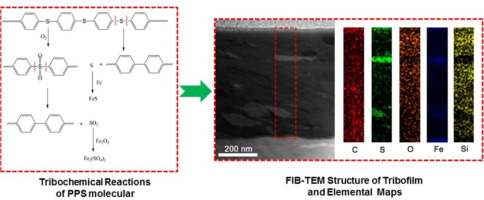Journal of Colloid and Interface Science ( IF 9.4 ) Pub Date : 2017-12-29 , DOI: 10.1016/j.jcis.2017.12.078 Huimin Qi , Ligang Zhang , Ga Zhang , Tingmei Wang , Qihua Wang

|
Hypothesis
Tribochemical reactions of polymer matrix with steel counterpart can exert an important role in tribofilm’s structure, and thereby affect the tribological performance of its composites.
Experiments
In the present work, tribochemistry of ultrahigh molecular weight polyethylene (UHMWPE), polyphenylene sulfide (PPS) and polyetherimide (PEI) in tribo-composites was comparatively studied. Two kinds of formulations, i.e. conventional composites filled with carbon fibers and graphite and hybrid nanocomposites containing additional silica (SiO2) nanoparticles, were investigated.
Findings
It was revealed that when rubbing with steel, molecular chains of UHMWPE were broken and free radicals finally chelated with the counterface. Whereas, PPS molecules underwent thermal decomposition, oxidation and finally ferrous sulfide (FeS) and ferric sulfate [Fe2(SO4)3] were generated. Chelating reaction of PEI was identified only for sliding of PEI-based nanocomposite. Tribochemistry of polymer molecules played an important role in tribofilm formation and tribological performance of the conventional composites. When sliding took place with the hybrid nanocomposites at low pv conditions, tribochemistry of polymer molecules played a similar role as for the conventional composites. Nonetheless, at high pv conditions, independent on the polymer matrices, robust tribofilms containing high fraction of silica were generated on the steel counterface, minimizing direct rubbing of the friction pair.
中文翻译:

摩擦复合材料中超高分子量聚乙烯,聚苯硫醚和聚醚酰亚胺的摩擦化学比较研究
假设
聚合物基体与钢对应物的摩擦化学反应可在摩擦膜的结构中发挥重要作用,从而影响其复合材料的摩擦学性能。
实验
在目前的工作中,对摩擦复合物中超高分子量聚乙烯(UHMWPE),聚苯硫醚(PPS)和聚醚酰亚胺(PEI)的摩擦化学进行了比较研究。研究了两种配方,即填充了碳纤维和石墨的常规复合材料以及包含额外的二氧化硅(SiO 2)纳米颗粒的杂化纳米复合材料。
发现
结果表明,与钢摩擦时,UHMWPE的分子链断裂,自由基最终与配体螯合。而PPS分子经历了热分解,氧化作用,最后经历了硫化亚铁(FeS)和硫酸铁[Fe 2(SO 4)3]生成。仅对基于PEI的纳米复合材料的滑动鉴定出PEI的螯合反应。聚合物分子的摩擦化学在常规复合材料的摩擦膜形成和摩擦学性能中起着重要作用。当杂化纳米复合材料在低pv条件下发生滑动时,聚合物分子的摩擦化学作用与常规复合材料相似。尽管如此,在高PV条件下,与聚合物基体无关,在钢对面仍生成了含有大量二氧化硅的坚固的摩擦膜,从而最大程度地减少了摩擦副的直接摩擦。











































 京公网安备 11010802027423号
京公网安备 11010802027423号